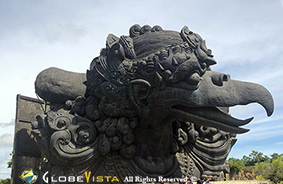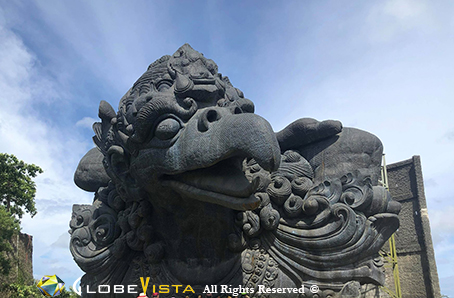Garuda statue

Public Art: Garuda statue
Sculptor: © Nyoman Nuarta
Date Unveiled: August 2018
Description: The statue is of Indonesia’s national emblem, the mythical bird Garuda. The ancient bird is part of the Hindu, Buddhist and Jain mythology. Garuda is described as being is half human half bird with a white face and red wings. Garuda was so big that when it flew by it would block the sun.

Location: The Garuda statue is located at Garuda Wisnu Kencana Park, Ungasan, Badung, Bali, Indonesia
Garuda Legend:
Garuda is acknowledged in Indian, Cambodian, Indonesian, Thai and Myanmar culture. As would be expected there are numerous myths and legends surrounding Garuda. The Indonesian myth revolves around Garuda, his mother and the search for the elixir of life.
As the story goes, Garuda was the product of Resi Kasyapa and Winata, one of his 29 wives. Garuda also had a brother Aruna, and 1000 half brothers (who were cosmic snakes) by his stepmother Kadru. Before Garuda had hatched Winata and Kadru got into a heated argument over Ucaisrawa, a cosmic horse. Kadru claimed that the horse’s tail was white and black whilst Kadru was adamant that the tail was simply white. As tempers flared they decided to make a bet. Whoever was wrong had to become the other woman’s slave. Unbeknown to Winata, this was all a trap. Kadru knew the horse’s tail was white. She had her children snakes spray part of Ucaisrawa’s tail with their venom turning it black. Honouring the bet, Winata became Kadru’s slave. Meanwhile, Garuda had hatched. His glare was so powerful it lit the heavens and scared the gods. When Garuda discovered his mother’s fate he approached his half-brothers, the snakes. He asked them how he could buy back his mother’s freedom. They told him the only way would be to find amerta, the elixir of life, and give it to them in exchange.
Before setting out on his quest he visited his mother. She told him that to obtain the amerta he had to venture to the island with the holy mountain. The amerta was there but guarded by villains. In order to survive the journey, he needed to kill and eat the villains. However, she warned Garuda not to kill the Brahmin, as his father was a Brahmin. Winata assured her son that he would be protected by several gods. Bayu, the god of energy will look after your wings; Candra, the goddess of the moon, will have your back and; Agni and Angin, the gods of fire and wind, will protect your head. With this, the mighty beast flew off.
On reaching the island he began slaughtering the villains and feasting on them until he reached the peak of the holy mountain, Somaka. There he was set upon by Indra’s troops. Indra was the king of the gods. With his talons, claws and powerful beak Garuda killed them all one by one. He then swooped down off the mountain with his mighty wings to the sea where he collected water. He used the water to put out the fire guarding the entrance to the amerta cave. All that remained was for him to kill the two Nagas (snakes) guarding the elixir of life. After making a meal of them he took the amerta and flew off.
Just as Garuda was nearing home the god Wisnu (protector) saw him carrying the amerta. Wisnu asked Garuda if he would become his transport to fly him where ever he was needed in the world. In exchange, he would allow Garuda to use the amerta to free his mother. Unable, by law, to deny him, Garuda granted the request. Garuda carried the amerta back to his half brother snakes. On seeing the great bird with the elixir in his claws they released Winata. Garuda told the snakes before he would hand over the amerta they must cleanse themselves. As they slithered off, the now angry god Indra suddenly appeared and stole back his precious amerta. Garuda in the meantime had flown off to serve Wisnu.
In Indonesian mythology, Garuda became the symbol of sacrifice and loyalty.
Things you may not know:
The Garuda Wisnu Kencana Park project was 25 years in the making and cost over $100 million.
Indonesia’s national emblem was originally designed by Sultan Hamid II following Indonesia’s Independence. It was later changed by the first president, Soekarno. Over the next few years, it was modified more and more until the “human” and “mythological” elements disappeared. It eventually took shape to look like the Javan Hawk-eagle. The crest was added to differentiate it from the American bald eagle.
If you look at the Garuda national emblem, the bird includes 8 strands of feathers on the tail, 17 feathers on each wing, 19 feathers under the shield and 45 strands on its neck. If you put it all together it symbolizes Indonesia’s date of Independence, August (8th month) 17, 1945.
Acknowledgments: Thank you to Kristen Montague and Sarah Montague for kindly supplying the photographs.